3 More Italian Cities to Visit plus 2 Spirited Locals Attractions
Here are three interesting Italian cities to visit plus some activities to consider when you visit Italy. Messina which is in the northeast of Sicily, Italy.
Rome which is one of the oldest continuously occupied cities in Europe. Also Ostia Antica a large archeological site.
10 Best Places To Visit In Italy – Travel Video
by touropia
Published on Youtube on May 3, 2019
Located in Southern Europe, this boot-shaped country is one of the world’s most popular travel destinations for a number of reasons that include art treasures, trendy fashion, stunning landscapes, passionate people and top-class cuisine. Italy offers so much to see and do that it would take a lifetime to explore.
Carnevale di Venezia, a 12-day Winter Festival is also a great winter attraction.
Aso there is the Carnival of Venice you must definitely consider visiting if the time of year is right. If you’re in the area visit The Palio is a Medieval Tradition in Siena.
1. Messina Sicily
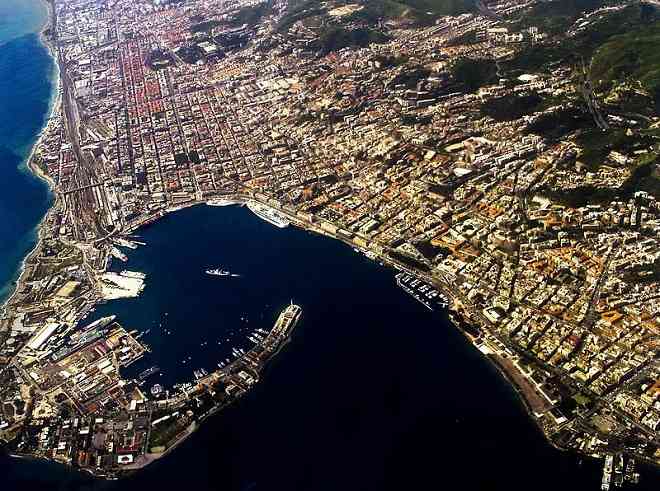
Falce del porto di Messina, San Raineri. Photo by Stefano Barillà / CC BY-SA 3.0
Messina is in the northeast of Sicily, Italy. It is only 5 km across the Straits of Messina to the region of Calabria on the mainland.
Founded by Greek colonists in the 8th century BC, Messina was originally called Zancle because of the shape of its natural harbor.
The city reached the peak of its splendor in the early 17th century, under Spanish domination. At the time it was one of the ten greatest cities in Europe.
In the past, Messina like now was the main portal to Sicily. Greeks, Romans, Byzantines, Arabs, and Normans landed on its coasts.
They had a heavy influence on culture here and throughout the Island. By exploring the small provincial towns, one can discover precious works of art in its churches and palaces.
You’ll also see important traces of great and faraway civilizations. Messina is known as the door of Sicily. It has always been a trading city.
There has been busy thoroughfare between Messina and the Mainland, over the ages. In recent years, there’s been talk of constructing a bridge to facilitate and improve communication.
Unfortunately this would be almost impossible to implement due to the fragile nature of the coastline and problems with erosion.
The main method of transportation between Sicily and the mainland still remains a system of ferries. That has been the tradition throughout the centuries.
Although it has had a rocky history, Messina is a thriving town with yearly festivals and celebrations of its long history.
In the middle of August the Ride of the Giants takes place, with two enormous statues, one black and one white, known as Grifone and Mata.
They are paraded through the city on horseback in celebration of the mythical founder of the city.
Those arriving in Messina by boat can circumnavigate the coasts. You can enjoy the spectacular hollows and giant boulders, rocks and mounds that surround the islands’ shores.
The Aeolian Archipelago is a real paradise for trekkers. Take one of the hiking trails that seem to go on forever.
Hikers can experience a journey of landscapes, showcasing the islands’ diverse beauty as they trek the island.
2. Rome Italy: the Eternal City
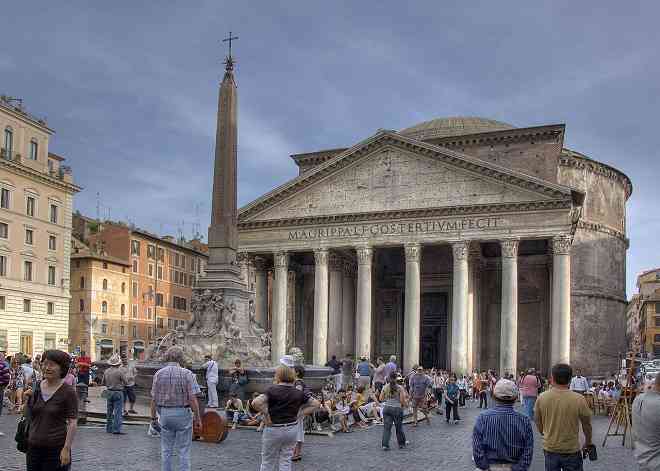
The Pantheon.
Rome’s history spans more than 2500 years, since its founding in 753 BC. Rome is one of the oldest continuously occupied cities in Europe.
It is referred to as “The Eternal City.” It is regarded as one of the birthplaces of Western civilization.
Rome’s status is that of a global city. In 2011, Rome was the 18th-most-visited city in the world, 3rd most visited in the European Union. Rome is the most popular tourist attraction in Italy.
Its historic center is listed by UNESCO as a World Heritage Site. Monuments and museums such as the Vatican Museums and the Colosseum are among the world’s most visited tourist destinations.
Both of these locations receive millions of tourists every year. Rome is definitely one of the most important tourist destinations of the world.
 Its due to the immensity of its archaeological and artistic treasures, as well as for the charm of its unique traditions.
Its due to the immensity of its archaeological and artistic treasures, as well as for the charm of its unique traditions.
The beauty of its panoramic views, and the majesty of its magnificent parks also help it to be a preferred tourist destination.
Nature reserves and public parks cover a large area in Rome. The city has one of the largest areas of green space among European capitals.
Rome is famous for its many fountains, built in all different styles, from Baroque and Neoclassical to Classical and Medieval.
The city has had fountains for more than 2000 years which have provided drinking water and decorated the piazzas of Rome since then.
Rome is well known for its statues. In particular, the talking statues of Rome. Usually these are ancient statues which have become popular soapboxes for political and social discussion.
They are places for people to voice their opinions. The city of Rome also contains numerous famous bridges which cross the Tiber.
According to the Encyclopedia Britannica, the finest ancient bridge remaining in Rome is the Ponte Sant’Angelo, which was completed in 135 AD.
It was later decorated with ten statues of the angels. Click here to read more.

3. The Roman Site of Ostia Antica
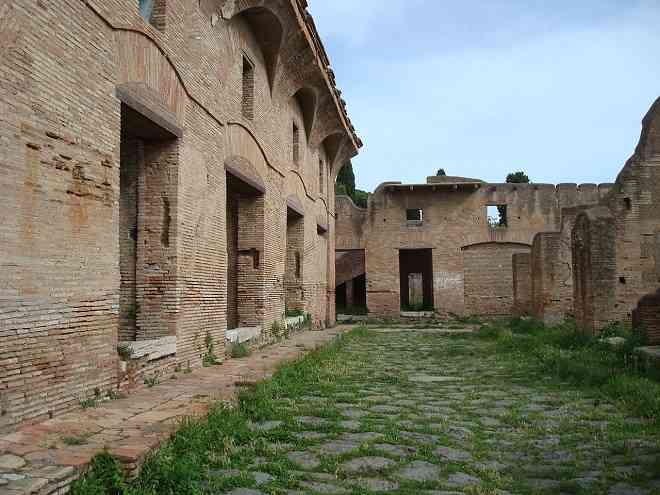
Roman insulae in Ostia Antica.
Close to the modern suburb of Ostia, lies Ostia Antica a large archeological site, that was the location of the harbor city of ancient Rome.
It is approximately 30 kilometers (19 miles) to the northeast. With the end of the Roman Empire, Ostia fell slowly into decay.
It was finally abandoned in the 9th century due to the repeated invasions and sackings by Arab pirates.
Ostia was Rome’s seaport located at the mouth of the River Tiber. But due to silting the site now lies 3 kilometres (2 miles) from the sea.
The site is noted for the excellent preservation of its ancient buildings, magnificent frescoes and impressive mosaics.
2 Italian Attractions to Feel the Spirit of the Locals
1. Do you know about the Carnival of Venice?
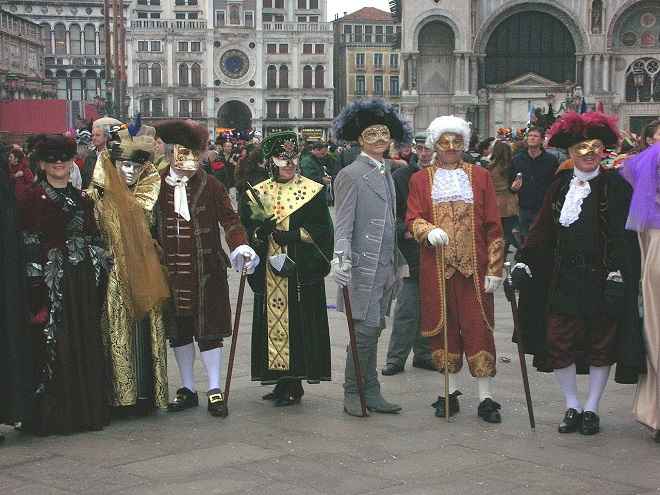
Carnival of Venice. Photo by Alan Light / CC BY-SA 2.0
Its the Carnevale di Venezia (Carnival of Venice)! you will experience a one-of-a-kind time travel and enjoy a vibrant colorful festival and exciting adventure of being behind a mask.
Masks have played a significant role in human history for various purposes and occasions – arts, theater, literature, politics, socials, and culture.
Venice, however, knows best how to celebrate this centuries-old tradition of wearing fancy masks and sophisticated costumes.
A History of Masks in Venice
Beyond this bright and spectacular festival where everyone is elaborately dressed from head to toe in a costume and mask. It is a history of masks in Venice.
Carnevale has been around since the 15th century when attendees wore masks to private parties with extraordinary entertainment such as inciting a bull.
Back then, wearing a mask also afforded Venetians concealment of mischief, like gambling, love and business deals, and even sneaking into convents of nuns.
It was scrapped altogether in 1797 with a decree of prohibiting citizens to wear masks. However, almost 300 years later it has been revived and is now known as one of the world’s most famous masquerade festivities.
Carnevale di Venezia – a 12-day Winter Festival
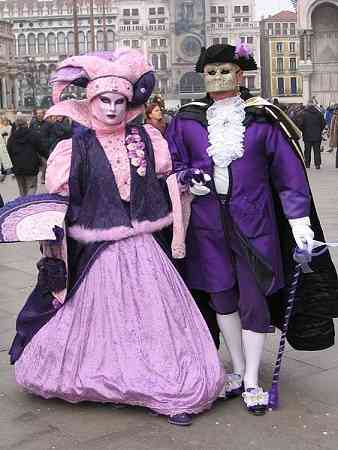
Venezia carnevale costumes. Photo by wanblee / CC BY-SA 3.0
It is best to check the schedule ahead of planning your visit because it sometimes falls in January or February. The Carnevale opens with a beautiful procession called La Festa delle Marie on a Friday afternoon.
At around 4PM the following day, the festival formally begins with a procession around the streets. The starting point is at the Piazza de Marco, where most of the main events are held.
Here you will find locals wearing their best masquerade attire. It is always complimented by an equally intricate mask.
Walk around and take snapshots of your favorite costumes with antiquated Venetian edifices as the background.
Outdoor Events and Carnival Entertainment
There are many outdoor events in store for you during the week. Bask in cultural and carnival entertainment watching street performances in the main squares.
There are classic musical and theatrical plays. On weekends you shouldn’t miss these in the Gran Teatro at Piazza de Marco.
There is a romantic candlelight water parade after you exit the canals on Shrove Tuesday. The parade consists of gondolas and boats that are lit with frail candlelight.
This “Fat Tuesday” is also the perfect time for wild Italian parties you may want to join since everyone is out and ready to dance the night away.
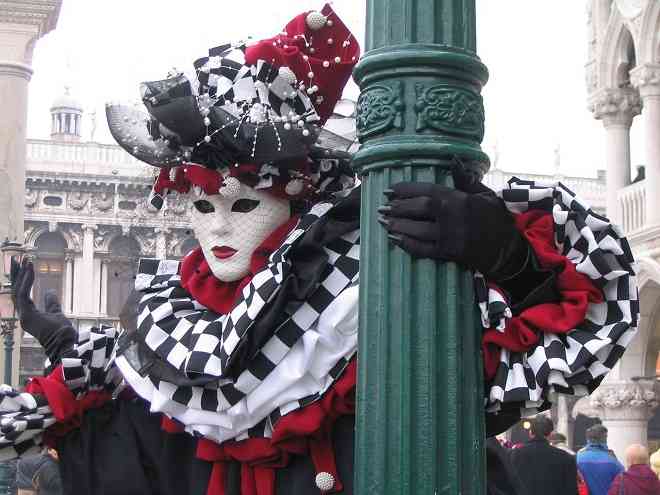
Venezia carnevale costume lady. Photo by wanblee / CC BY-SA 3.0
Friday is the high point of the festival. The Gran Ballo del Maschere is usually held in the grand palace. You could join in this momentous party with your perfect costume and mask.
Put your dancing shoes on since this is also a night of Venetian quadrilles. That’s a square dance for four couples, consisting of five parts or movements, each complete in itself. It’s a dance from centuries past.

Enjoy Italian Cuisine, Relaxing, and Ice Skating
Of course, a food trip tasting the goodness of authentic Italian cuisine is a must. After you enjoy a delicious meal, take a relaxing stroll along the side streets of old Venice.
Then end the day with a quiet afternoon at St. Mark’s Basilica. If you are up for some skating, put your blades on as Campo San Polo opens an ice skating rink.
Don’t forget to scour the shops for fine Venetian masks and costumes to use when hanging around the plaza to complete your masquerade adventure.
With an early reservation, you may also attend high-end carnival balls. You will never run out of wonderful and exciting things to do at this delightful festival! It is truly one-of-a-kind.
The Carnivale culminates with a majestic finale: Notte de la Taranta (Night of the Tarantula) where a massive fireworks display fills the sky.
End the festival with a grand street party. This is one festival guaranteed to bring you wonderful and colorful memories that will last a lifetime.

2. The Palio di Siena
Siena is one of the favorite cities to visit in Italy. Although, it is not as prominent or well-known as Rome or Venice, the city is a model of Italian culture and grace. The city can be found in the beautiful sunny region of Tuscany.
Its atmosphere, charming squares, flower-fringed courtyards, red-brick lanes coupled with red-tiled rooftops, and its vibrant historic center, will make you feel good you’re in one of Italy’s most perplexing cities.
Siena’s high stature as an Italian tourist destination is boosted even more during the celebration of the Palio. This is after all the most famous horse race in all of Europe.
The Palio is a Medieval Tradition
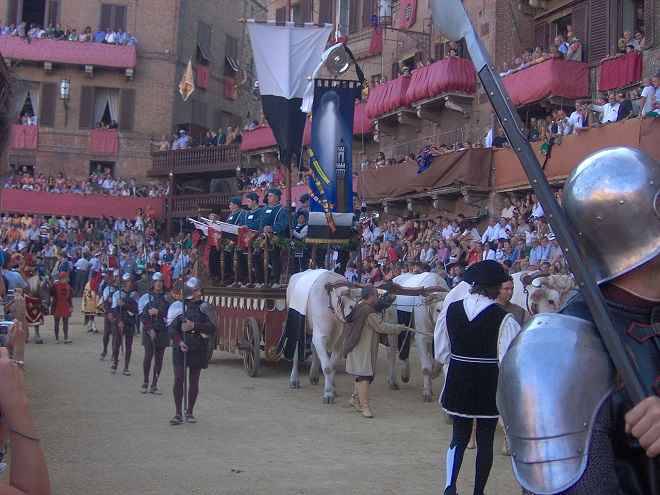
The carroccio of Siena during the Corteo Storico procession preceding the Palio of August 2006. Photo by William Domenichini / CC BY-SA 3.0
The Palio is a well-loved medieval tradition and Siena’s grand tribute to its glorious past. This iconic horse race is held every July 2 and August 16.
It features 10 out of the total 17 contrada or districts in the city, competing in trial races and in the main horse races.
Who gets to compete for the year’s event is chosen through a lottery and rotational system. Know that Siena locals do not take the race lightly.
They look at their jockeys as war champions, and they even have the competing horses blessed in their own parish church.
People are Passionate about the Palio
Notice locals get genuinely upset if their champion did not bring home the glory. During the days leading up to the event, it is common to see individual neighborhoods display their colorful banners and mascots.
They sing their special anthem and hold vivacious parades. The fighting spirit and passion of Siena’s locals will earn nothing but your admiration.
The main venue for the race is the medieval Piazza del Campo. Here, locals and tourists rub shoulders and push against each other.
Its all in the name of getting a fantastic view of the horses running wildly around the square. The crowd can easily swell up to 60,000 people. All of them cheering for one horse or another.
Everyone is Hungry for Victory
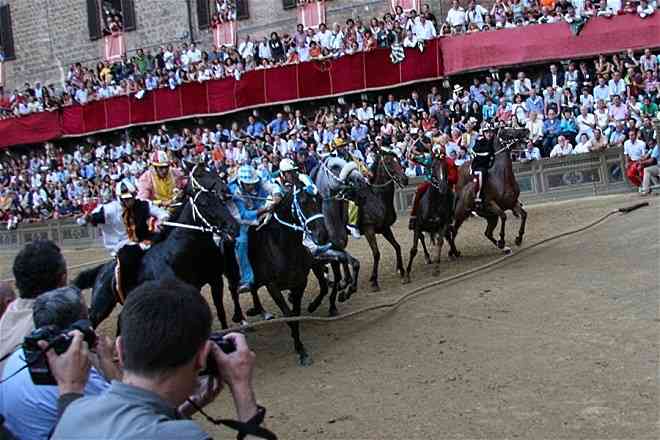
Everyone is hungry for victory. No one is going to stop a horse from winning, even if the rider has fallen off. For this reason, the Palio is truly a distinct, wild and fascinating event.
You won’t find this kind of passion in horse races in the United States. Not even in the famed Kentucky Derby.
The celebration starts even before the actual race. Representatives of each district wear elaborate medieval costumes and take part in a grand procession.
This lavished parade also highlights the district’s flag-hurlers who usually show off their flag “exhibition skills”.
You can go Early to Witness Pre-race Trials
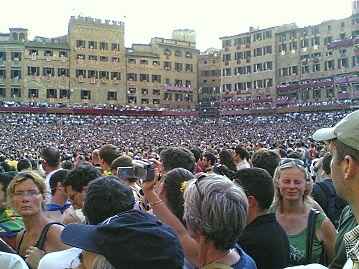
The crowd fills the Piazza del Campo just before departure.
Look at the crowds and you’ll see why a bleacher seat might be a good idea. You don’t have to enjoy the Palio only during the race day.
Three days before the main event pre-race trials are conducted and are very interesting to witness. If you have chosen to cheer for a certain district, try to attendingtheir outdoor dinner called cena della prova generale, organized on the eve before the Palio.
Book Everything Well in Advance
 If you want to experience the madness and marvelous spirit of Palio di Siena, you must book everything in advance.
If you want to experience the madness and marvelous spirit of Palio di Siena, you must book everything in advance.
Accommodations, dinner reservations and seat tickets must be arranged six months ahead. There are many tour companies online that offer their services.
If you can, stay within Siena itself instead of the neighboring cities.
This can save you a lot of time and hassle because the traffic going into the city is expected to be very heavy.
Italy’s Climate and have you experienced any of these?
Of these Italian cities to explore, which ones have you visited? If none, and you visit Italy you must visit at least a couple of them to make your trip complete.
Italy’s climate is highly diverse, and could be far from the typical Mediterranean climate. Most of Italy has hot, dry summers, with July being the hottest month of the year.
Visit Italy – The DON’Ts of Visiting Italy
by Wolters World
Published on Youtube on Nov 12, 2016
Visiting Italy is an amazing experience whether you are seeing the Roman ruins throughout the country in places like Rome or Naples, but for all the amazing things you should do in Italy (visit Venice, Florence, Rome, Ravenna, Amalfi Coast, eat until you explode) there are things you DON’T DO when you come to Italy & Here are our 12 things NOT TO DO in Italy when you are traveling Italy.
The Don’ts of Italy
1. Don’t expect to get discount prices on fancy Italian luxury brands. 2. Don’t eat near tourist sights. You will be ripped off and not get as good of Italian food as you would away from the tourist sights. 3. Don’t Tip. They already charge you for service. 4. You Don’t have to scream louder to get people to understand you. 5. Don’t worry about overdressing, the Italians will always look better than you. 6. Don’t just visit Rome and Venice, there is so much more to Italy.
7. Don’t share your pizza and make sure you do eat it with your fork and knife. 8. Don’t use the fast trains for short distances, they are not worth the significantly higher prices. 9. Don’t expect to see spaghetti and meatballs on the menu TOGETHER. They will be there separately, but not together. 10. Don’t expect a big breakfast in Italy. Just coffee and a cookie. 11. Don’t overpack. You will be limited on space when traveling in Italy so pack accordingly. 12. Don’t expect to be served food in a restaurant between 3pm and 7pm.
Winters are damp and cold in the North, but milder in the South. On peninsular coastal areas temperatures can be very different from the interior’s higher ground and valleys.
That’s especially true during winter months when higher altitudes tend to be cold, wet, and often snowy. Of course the Alps have a mountain climate, with cool summers and very cold winters.
About the Author
Charles writes articles and has several domains for sale. He also makes money as a senior citizen.







